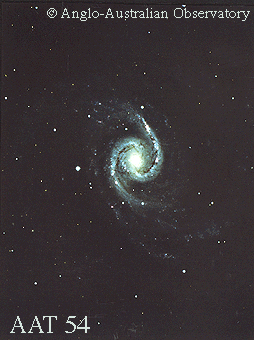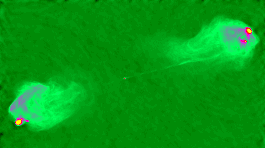
[Image source: Copyright © Anglo-Australian Observatory]
Blazars are a type of active galaxy which are still present today. Blazars, like quasars, were first discovered as ``quasistellar'' points of light. Blazars can vary significantly in brightness in less than a day, indicating that most of their light must come from a region less than one light-day across (about 200 AU). Long-exposure photographs of blazars reveal ``fuzz'' around the quasistellar source. The ``fuzz'' is elliptical in shape, and has the absorption line spectrum typical of ordinary galaxies. This indicates that blazars are elliptical galaxies with highly luminous central nuclei. (The nucleus itself has neither emission lines nor absorption lines in its spectrum).
Seyfert galaxies are a type of active galaxy; they are spiral galaxies with extremely bright nuclei. The luminosity of Seyfert galaxies ranges from 0.1 to 10 times the luminosity of our galaxy. About 2% of spiral galaxies are Seyferts. The spectra of Seyfert galaxies are characterized by emission lines from highly ionized gas. In some Seyferts, the emission lines are broadened by random motions up to 10,000 kilometers/second. Within the nuclei of Seyfert galaxies, then, there exists very hot gas which is swirling around very rapidly. The luminosity of the nucleus of a Seyfert galaxy can vary wildly on timescales of less than a month. This implies that the size of the nucleus is less than one light-month (= 5000 A.U. = 0.025 parsec). Thus, a very large amount of energy is emerging from a very small volume.
Aside from their bright nuclei, Seyfert galaxies look
like ordinary spiral galaxies. Here, for instance,
is the Seyfert galaxy NGC 1566:

[Image source: Copyright © Anglo-Australian Observatory]
Radio galaxies are a type of active galaxy; they are elliptical galaxies with jets of gas extending away from a central nucleus. The jets emit radio waves by the synchrotron process (electrons accelerated by a magnetic field). About 0.01% of all galaxies are radio galaxies. The luminosity of radio galaxies at radio wavelengths (just radio waves, not including shorter wavelengths) is from 0.1 to 10 times the luminosity of the Milky Way at all wavelengths.

At the heart of every active galaxy is a supermassive black hole. A `supermassive' black hole, in this context, is one with a mass of 1 million to 10 billion Msun. Black holes with masses in this range will have Schwarzschild radii of 0.02 to 200 A.U. (that's about 10 light-seconds to 1 light-day). Blackbody radiation comes from an accretion disk of hot gas swirling around the black hole like water around a drain. disk of hot gas swirling around the black hole. The gas becomes hotter and hotter as it swirls inward, so most of the light comes from the inner parts of the accretion disk (within 10 times the Schwarzschild radius). Instabilities in the accretion disk cause the variations in luminosity that are seen in Seyfert galaxies.
Why should a supermassive black hole produce jets?
We know, after all, that gravity is an
attractive force, not a repulsive force. If gas is falling TOWARD
the black hole in the accretion disk, why should other gas be
simultaneously accelerated
AWAY from the black hole in a jet? The detailed mechanism
which creates jets is poorly known, much to the frustration
of astronomers. The general picture, however, looks something
like this:
The inner regions of the accretion disk is very hot. It
is so hot, in fact, that gas starts to evaporate from the
disk. As the hot ionized gas drifts away from the disk, it is
accelerated and squeezed into a narrow jet by the disk's
magnetic field. As the electrons of the ionized gas are
accelerated by the magnetic field, they emit the synchrotron
emission that we detect with our radio telescopes here on Earth.
Now imagine that the accretion disk is tilted, so that you see it at an angle. In this case, you will see both blackbody radiation from the inner regions of the disk AND synchrotron emission from the jets. If the result is very luminous, you will call what you see a quasar; if it's a little less luminous, you will call it a radio galaxy.
Now imagine that you see the accretion disk face-on, so that one of the jets is pointing straight toward you, and the other one (pointing away from you) is hidden by the accretion disk. In this case, with a jet pointing directly at you, you will receive a huge quantity of synchrotron emission. The resulting radio source is what we call a blazar.
Updated: 2003 Mar 3
Copyright © 2003, Barbara Ryden